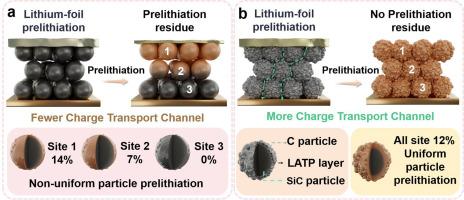A Mixed-Conducting Strategy Enabling Uniform Prelithiation of Silicon-Based Lithium-Ion Batteries
IF 5.6
3区 材料科学
Q1 ELECTROCHEMISTRY
引用次数: 0
Abstract
Prelithiation has been widely recognized as an effective strategy to mitigate the low initial Coulombic Efficiency of silicon-carbon (Si-C) anodes in lithium-ion batteries. Conventional prelithiation methods suffer from non-uniform lithium distribution and unstable formation of solid electrolyte interphase (SEI). To address these issues, this work introduced a mixed electron-ion conductor (MEIC) as a multifunctional additive to establish dual conductive pathways enabling concurrent electron and ion transport. This strategy enhances lithium-ion diffusion kinetics and charge transfer efficiency through a hybrid electron-ion conductive network. Physical characterizations reveal that the mixed-conducting strategy enables uniform prelithiation and promotes the formation of a stronger SEI. Electrochemical testing of full cells demonstrates that MEIC modified electrodes achieve an initial Coulombic Efficiency of 94.5% and a capacity retention of 66.1% after 500 cycles at 1 C, outperforming traditional contact prelithiation methods by 22%. Even at a high rate of 2.0 C, the capacity of MEIC-based electrodes is improved compared to conventional counterparts. Notably, this strategy is fully compatible with roll-to-roll manufacturing processes, offering a scalable pathway for high-energy-density Si-C anodes in practical applications.

实现硅基锂离子电池均匀预锂化的混合导电策略
预锂化已被广泛认为是缓解锂离子电池硅碳(Si-C)阳极初始库仑效率低的有效策略。传统的预锂化方法存在锂分布不均匀和固体电解质界面(SEI)形成不稳定的问题。为了解决这些问题,本研究引入了一种混合电子离子导体(MEIC)作为多功能添加剂,以建立双导电途径,实现电子和离子的同步传输。该策略通过混合电子-离子传导网络提高了锂离子的扩散动力学和电荷转移效率。物理表征表明,混合导电策略可以实现均匀的预岩化,并促进形成更强的SEI。完整电池的电化学测试表明,MEIC修饰电极在1℃下循环500次后,初始库仑效率为94.5%,容量保持率为66.1%,比传统的接触预锂化方法高出22%。即使在2.0℃的高速率下,meic电极的容量也比传统电极有所提高。值得注意的是,该策略与卷对卷制造工艺完全兼容,为实际应用中的高能量密度Si-C阳极提供了可扩展的途径。
本文章由计算机程序翻译,如有差异,请以英文原文为准。
求助全文
约1分钟内获得全文
求助全文
来源期刊

Electrochimica Acta
工程技术-电化学
CiteScore
11.30
自引率
6.10%
发文量
1634
审稿时长
41 days
期刊介绍:
Electrochimica Acta is an international journal. It is intended for the publication of both original work and reviews in the field of electrochemistry. Electrochemistry should be interpreted to mean any of the research fields covered by the Divisions of the International Society of Electrochemistry listed below, as well as emerging scientific domains covered by ISE New Topics Committee.
 求助内容:
求助内容: 应助结果提醒方式:
应助结果提醒方式:


